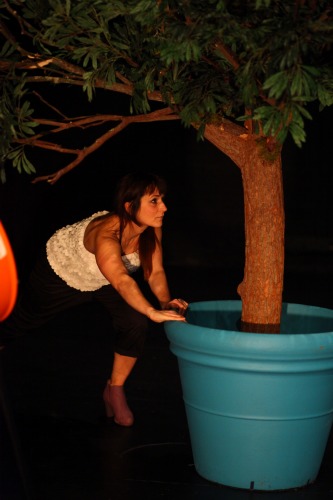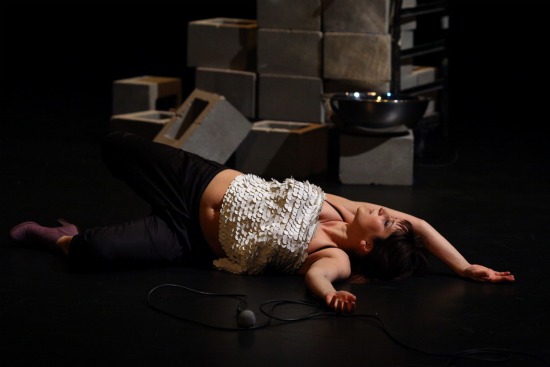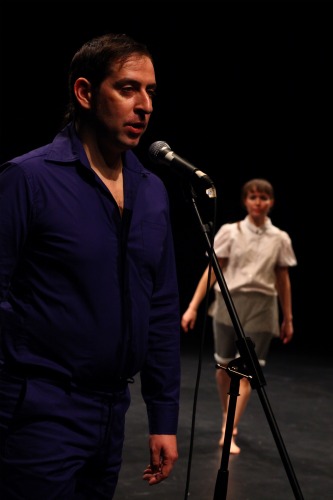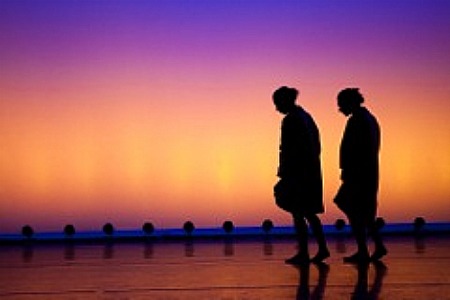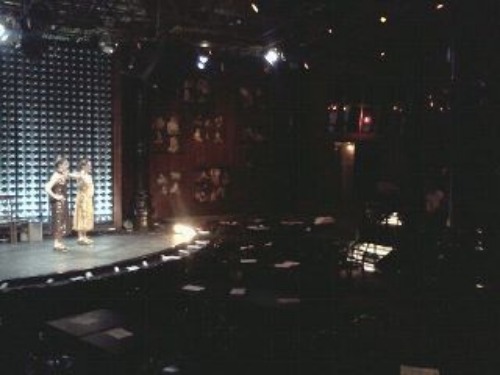What are we seeing? We’re seeing a woman kneel beside a large potted tree, and root around in its soil; she is nicely dressed in black pants, a ruched white top held up by tiny black straps, and high-heeled, little brown boots. That was an easy question. But, wait. How are we seeing it and through how many possible layers of meaning? (Is she cultivating the soil a bit, hunting for something—maybe a lost ring, or a memory?) How will this relate to other actions she may perform?
Or consider this. A man, clearly the choreographer, tells a solitary dancer to perform some of the stuff they worked on that isn’t in the piece that we’re watching. Except that now it is. What is he showing us? That the dancer is game, good-humored? That memory is fallible? Yes. But he’s also making us think about the traditional performer-audience relationship, and about process becoming performance. That may be why shortly after his piece begins, he stands awkwardly in front of a microphone and, after a few moments, says softly, “It’s scary up here.”
The woman with the tree is Amanda Loulaki performing her new solo, Untitled. The unpredictable choreographer is Levi Gonzalez, and he is performing his premiere, Counterfeit Scenario, with Natalie Green. Different though they are, their shared program at The Kitchen (February 9 through 11) is rife with provocatively equivocal images and apparent contradictions. What indeed are we seeing? And what has been left out?
The tree is not the only object that shares the stage with Loulaki (visual context and costume by Joanna Seitz). In a far corner of the black-box theater, an assemblage of gray concrete blocks forms a four-step staircase (I assume they’re lightweight look-alikes until I see the stage crew lugging them away afterward). Their sole function is to hold a large bottle of water; part way through the piece, Loulaki opens the bottle and carefully positions it so that the water will drip steadily and resonantly into a shiny steel basin placed on another couple of blocks.
Her actions suggest that she is recreating memories—not depicting them, but recollecting how she felt about them and images associated with them. (Two trees, not so incidentally, appeared in her 2007 Delirium). How we view what we are seeing becomes mind-boggling in the first moments of Untitled. Loulaki gets down on all fours so close to the front row that only those seated there can see her. The rest of us have to wait until her excruciatingly laborious backward crawl brings her into view, as a rumble and low, throbbing tone begin in Georgios Kontos’s sound score. Her head is hanging, and her rump is higher. How long can she keep doing this? When she stops and starts shifting her hips, it’s as if she has become her torso—that long, writhing slant from her neck to past her buttocks. When she stretches one leg to the side, it seems unconnected to the rest of her; her other leg behaves like a groping hand. The image is of a woman disassembled.
Everything she does is arduous. She twists and rolls and reaches out. Is she trying to turn over, sit up, wake up? Next to impossible. Standing, she wrenches her body from side to side. She pushes the tree to a new spot. Her body is a controlled disaster zone, but the voice she delivers into a hand-held mic is soft. “Have you ever seen a peacock try to cross the street?” she asks. “I watched him walk,” she says a few minutes later. She mentions a palace, a man whose fingers smell of tobacco: “I find that disgusting.” Scraps of music, nasal singing voices feed into the score. Joe Levasseur’s subtle lighting alters the emotional climate. As the stage finally dims, Loulaki is slowly pushing a large lamp toward the tree. By the time she gets where she’s going, it’ll be too dark to see where that is.
Not far into Gonzalez’s Counterfeit Scenario, I want to hit him with something heavy. He’s definitely, knowingly, asking for it. After introducing Green as an equal (they both slog in separate, curving paths around the space, their bodies leaning forward, feet sliding along), he becomes the choreographer and she his willing instrument. Justin Luchter’s score, which has begun as a low rumble and yielded up a sudden crash, slips away, and Gonzalez, at the mic, makes increasingly impossible demands on Green. His voice never rises above an almost caressing tone. “Do a dance of intricate gestures,” he orders Green, then asks her to add “sweeping arcs of the limbs.” Her dancing is a marvel of intrepidness—fluid, articulate, rich, but Gonzalez’s’s ongoing advice results in conflicts and confusion. How is she to interpret “raw vulnerability?” The audience is onto him—hating the “choreographer,” chuckling at the absurdity of his demands.
You can laugh too at his monologue performed in near darkness; his soothing voice and suggestions for relaxing and sensing your inner motions could be related to any number of body-centered healers and teachers, except that his advice becomes creepier and creepier (my favorite: “feel your intestines slipping against each other”) and gradually veers toward suggestiveness. At the end, he invites the listeners (not us, but us), with their now decomposed bodies, to stand up, if they can.
Once Green goes to the mic, but finds she has nothing she wants to say. However, along with occasional remarks by Gonzalez about what they should be doing (he isn’t sure), the two do dance together. Throbbing musical tones and what sound like submerged Irish voices creep into the score, then a bass sound so low it makes your stomach vibrate. Gonzalez and Green walk along, mirror each other, and dance in understated side-by side unison, as if they’re having a nice, easy-going time. And we’re left to applaud the very theatrical anti-theatricality of the piece, and to head home contemplating what’s counterfeit and what’s real, and how much of the “realness” might be an illusion and the presumed spontaneity planned. Even when you believe you have the answers, you know Gonzalez has counted on your asking the questions.
And now for something completely different. Yet, deep down, maybe, not all that different. Monica Bill Barnes’s witty and accomplished theatrical dances are often built on contrary notions of ineptitude, awkwardness, and embarrassment—even failure. Her The Snow Globe Show is about trying to put on a show and get a life and, often as not, being thwarted. She and Anna Bass—who has been her accomplice since 2003—are the girls who put a brave face on not being asked to the prom and the dogged troupers who get passed over for ones curvier and blonder.
Joe’s Pub—handsomely reconfigured last Fall to hold more people—is where DanceNow is presenting The Dancemopolitan 2012 Featured Artist Series, and the funky club, with its pocket-sized stage, is a perfect setting for The Snow Globe Show’s blend of glitter and down-home bravado. The beginning says a lot. Barnes and Bass—wearing sneakers and padded black overcoats like those you see on every other New York woman these days—wend their way through the drinkers and diners, carrying a small proscenium arch that looks as if artistic parents had concocted it for a first-grade show. They get two audience members to brace it while they attach it to frame the entrance at the back of the stage and to help them bring in boxes of stuff and sweep the floor. (The women also have a portable vacuum, an adhesive roller to dust the curtains, and a spray bottle of disinfectant—perhaps a dog act and a comedian left the place grubby). They whisper counts silently while practicing a terse, clever little routine of gestures to “Rollin’ on the River.”
Off come the coats. Ta-da! Barnes’s dress is solid gold spangles, Bass’s glitter runs toward bronze (costume and set design by Kelly Hanson). They share lipstick and hair spray and sit down to change shoes. It takes a moment to realize that the “stage” shoes are also sneakers, but with spangles glued on. This sister act may not be fully fledged; now and then one of them pulls out a camera, and the two take photos of each other or press their cheeks together and snap the shutter.
They’re not the sole entertainers. Like proud teachers, they usher in 23 members of the Juilliard Freshman Class (for whom Barnes choreographed a piece this past Fall). These dancers, dressed to party, pair up and, to the treacly “Amor”, slow dance in the aisles and among the tables. To enhance the romance of it all, Barnes stands on a chair and grasps a suspended mirror ball; Bass turns her, and the ball slowly rotates. Making do is routine to them. When Otis Redding launches “Shake,” the kids take his advice and get faster and raunchier, work into line dancing, and exit to applause.
Bass and Barnes also get partners. Almost. Jeffrey Kazin, suave in a suit, and Kevin Townley, looking like an escapee from a production of Bye-Bye Birdie, lip synch songs (“I love you more than words can say. . .”, adding a little of their own vocal schmaltz, but they gradually become more interested in each other than in the enchanted Barnes and Bass. Arms straight, hands one each other’s shoulders, the women re-think their routine as a duo. As with all the dancing, every step and reaction is carefully constructed and cleverly timed to look slightly off-kilter.
Bowing to a song’s taped applause and putting on their old sneakers, the two begin jogging around the tiny stage to Icelander Ólafur Arnald’s dreamily sweet piece for piano and cello, “Undan Hulu.” Throwing in a kick or two now and then, they keep running, leaning into their stride, increasing the length of it until it’s almost a low leap. They hold up their arms in triumph as they reach the invisible goal in the sunset glow of Jane Cox’s lighting.
Then they take another photo, pack up, put on their coats, and start carting boxes away. Their last act is to lug the little curtained arch through the applauding crowd. It’s not easy to do, and I feel the prickle of tears. “I can’t help falling in love with you,” sings Elvis. And if you aren’t already in love with these two plucky performers, with their terrific rendition of oddball numbers— maverick-chorus-girl routines, telling facial expressions, and all— you will be now.

